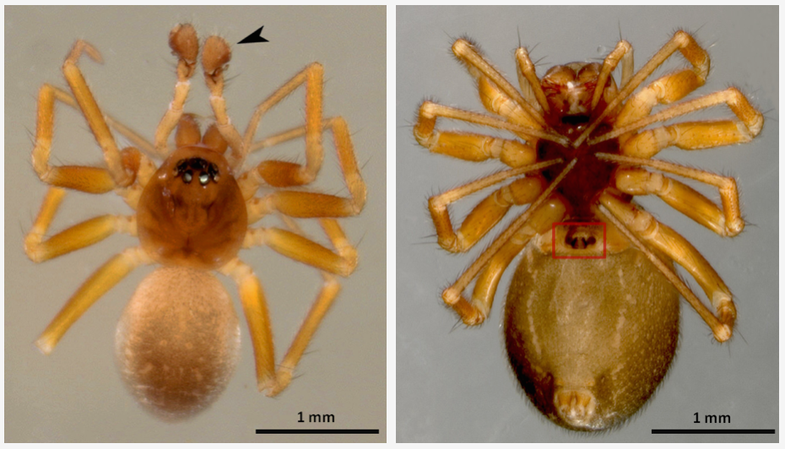How Male Dwarf Spiders Use Chastity Belts to Safeguard Their Fatherhood
As a courtesy to bug-phobes, some of the more lurid images in this post will be hidden until and unless...

As a courtesy to bug-phobes, some of the more lurid images in this post will be hidden until and unless you press this button.
SHOW
Animals don’t have actual chastity belts. But male creatures have evolved some interesting ways to try and ensure they’re the only ones who can access a particular lady.
The scarlet dragonfly, for example, has barbs on its sex organ that scrape out rival males’ sperm from a female’s genital tract. Or creatures might take a more defensive position, blocking other males from depositing their genetic material after they’ve done the deed. Evidence for these “mating plugs” exists in almost all animal groups. A new study describes how one species of spider uses them, and how well they work.
A male dwarf spider uses a plug to seal up its mate, ensuring nobody else can deposit sperm in the female’s sperm storage locker. After a day or so, the plugs are hardened enough to block entry by any other spider — even if the female is up for a new dalliance.
Spiders have some incredibly bizarre mating habits — widow spiders, amirite? — but the physiology itself is interesting. Males produce sperm in their abdominal organs, and then they pick it up in their pedipalps, which are small claw-looking appendages in the front of their bodies. They’re like the second, smaller pair of antennae you see on the face of a lobster and some other crustaceans.
The pedipalps have several parts — some help the spider digest its food, and the very ends develop into sperm-transfer organs. Females have two genital openings, which can accommodate the male’s two pedipalps. They store the sperm and choose when to fertilize their eggs.
Gabriele Uhl of the Zoological Institute and Museum in Greifswald, Germany, demonstrated that after inserting their pedipalps and mating, dwarf spiders in the species Oedothorax retusus left behind mating plugs in the females’ genital openings. Katrin Kunz, also of the Zoological Institute, set out to determine how this works.

Kunz discovered that the males transfer plug materials in liquid form, and then it has to harden to withstand other males’ mating attempts. Bigger mating plugs, which form in longer mating sessions, are more effective than short plugs, the researchers found.
To test this, Kunz and her colleagues got some spiders together and let them begin mating. Their copulation was stopped after one or three minutes, creating two groups to test. Then the spiders were mated again, after 15 minutes, one hour, one day, three days and after the female had deposited her eggs. The scientists scrutinized the female spiders with a scanning electron microscope.
Smaller, one-minute plugs were less effective, and plugs were less effective generally for spiders that re-mated right away, they found. Once plugs were a day old, they were very good at blocking entry by sperm from other spiders.
“The mating plug in the dwarf spider clearly functions as a mechanical obstacle to rival males,” says Kunz in a statement.
It’s an important addition to the bizarre annals of spider mating behavior — and to the chastity-belt-like strategies of the animal kingdom.
Reference: Kunz, K. et al (2014). Does the size and age of mating plugs alter their efficacy in protecting paternity? Behavioral Ecology and Sociobiology